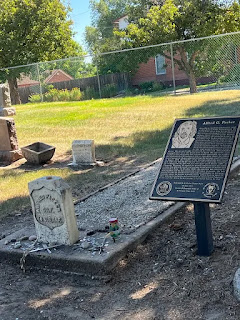As the Black Hills gold rush attracted more gold miners and fortune-seekers, the amount of gold, coins, and valuable paperwork being shipped between Deadwood and the railroad at Cheyenne reached record levels. They attracted numerous gangs of road agents determined to rob the coaches along the remote sections of the route.
Johnny Slaughter, murdered by road agent, Robert McKimie, on March 25, 1877, became the first Cheyenne and Black Hills Stage Company driver killed while operating the stagecoach along the Deadwood to Cheyenne Trail. Not long after, the company built two steel-plated treasure coaches called Monitors after the Civil War ironclad, USS Monitor. One was named “Old Ironsides,” which was designed and constructed by A.D. Butler of Cheyenne at the cost of $31,000. A few months later, a second coach, the “Johnny Slaughter” to honor the company’s late driver, was built and delivered by the same company.
 |
| The "Salamander" |
The stagecoach company commissioned a treasure box especially designed to thwart road agents. Manufactured in Cincinnati, the chest was lined with three-inch, thick steel and was bolted to the floor. It was secured with a Yale lock guaranteed to befuddle thieves for “six days.” Due to the coating of green paint on the outside, it quickly earned the nickname of “the salamander.”
 |
| Labeled a treasure coach, but does not show iron plating. |
Both stagecoaches were lined with steel plates 5/16th inches thick. Each door had a porthole for two shotgun messengers to shoot out. In addition to the structural reinforcements, armed guards, or “outriders” were added. Some scouted the terrain ahead and others escorted the coach itself.
Since large quantities of wealth were at stake, the road agents responded accordingly. Gangs grew larger and more violent.
In May 1878, the first Monitor coach, “Old Ironsides,” went into service. It was put to the test in what became known as the Canyon Springs Robbery.
 |
| 1914 recreation of "Old Ironsides" |
On September 26, 1878, Lame Johnny’s gang of outlaws ambushed the Monitor, starting with a hail of gunfire as it pulled into Canyon Springs Station thirty-seven miles south of Deadwood. The driver Gale Barnett and two shotgun messengers, Gale Hill and Eugene Smith, were wounded; and a telegraph operator named Hugh Campbell was killed.
 |
| Canon Springs Station 37 miles south of Deadwood |
This robbery was well planned out. The gang knew the timing of the stagecoach’s arrival at the station, which was thirty-seven miles south of Deadwood. One gang member approached the station and asked for a drink of water. As soon as the stock attendant, William Miner, started for the water, the outlaw attacked and locked him in a prisoner in the stable grain room. Before the coach arrived, other gang members knocked spaces out of the stable walls to use as gun ports.
As the stagecoach approached, they followed their usual procedure. The driver sounded a horn to alert the attendant to bring out a fresh team of horses. When no one appeared, two men in front dismounted to check for the attendant. Those road agents waiting in the barn opened fire. The driver returned fire, and then took cover after being wounded. There were dead and wounded on both sides.
Robbers took the driver as prisoner, using him as a shield. This made it impossible for Davis to continue firing for fear of hitting Barnett. He abandoned the fight, which left the robbers free to work on opening the salamander. They tied up the survivors and within two hours, they broke into the “break-proof” safe and escaped with valuables totaling $27,000.
Miner, the station attendant, eventually freed himself and walked to the next station to alert them to the robbery. It didn't take long for the story of the robbery to make its way around the Hills, and a posse was formed to regain the treasure and capture Lame Johnny's gang.
The Monitors continued to be used to transport large cargoes of valuables for three years before their use was discontinued.
In my most recent release, Hal’s Lucky Escape, my hero finds work as a security guard for the Cheyenne and Black Hills Stage Company. His first escape was an entanglement with a mail-order bride with questionable intentions. The second was a robbery attempt on one of the coach runs. To find the book description and purchase options,
Please CLICK HERE
Sources:
https://truewestmagazine.com/article/surviving-a-stagecoach-robbery/
https://www.bhpioneer.com/opinion/robbing-the-monitor/article_5e7ab954-9e7f-11e0-a3b8-001cc4c002e0.html
https://www.historyisnowmagazine.com/blog/2023/8/9/stagecoach-robberies-in-the-american-west
https://truewestmagazine.com/article/the-original-war-wagon/
https://shipwrecklibrary.com/deadlands/deadwood-stage/





















